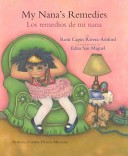
A little girl tells how her grandmother makes special teas and warm drinks for her and her little brother when they are not feeling well.
See the review at WOW Review, Volume 3, Issue 2

A little girl tells how her grandmother makes special teas and warm drinks for her and her little brother when they are not feeling well.
See the review at WOW Review, Volume 3, Issue 2
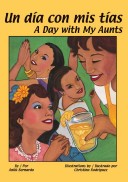
Isabel visits her aunts on Saturdays. They dance, dress up, and make empanadas.
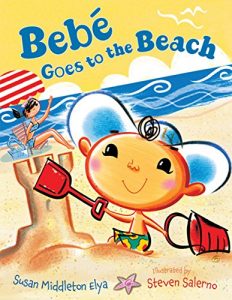 Mama leaves the shopping behind to spend a relaxing day at the beach. But sweet Bebe won’t sit still! He toddles after the waves, chases a bouncing pelota, and even surfs on a sand sculpture. When Bebé finally tuckers out, Mama gets her chance to soak up el sol. Mama and Bebe spiced things up in their first book together, Bebe Goes Shopping–and now they’re at it again! Includes a glossary of Spanish words.
Mama leaves the shopping behind to spend a relaxing day at the beach. But sweet Bebe won’t sit still! He toddles after the waves, chases a bouncing pelota, and even surfs on a sand sculpture. When Bebé finally tuckers out, Mama gets her chance to soak up el sol. Mama and Bebe spiced things up in their first book together, Bebe Goes Shopping–and now they’re at it again! Includes a glossary of Spanish words.
 An original take on losing a tooth. This little girl has tried everything to make her loose tooth come out before her dad’s birthday (except letting her brother yank it) so she’ll have money to buy him a gift. Nothing has worked and now it’s the big day. She just can’t go to his party empty handed! At the last second, her mom helps her think of a gift that doesn’t require any money—just imagination and heart. I have no dinero, this card’s all I’ve got. But, Papi, te quiero, I love you a lot. And her dad couldnÂ’t be happier. Susan Middleton Elya’s trademark mix of Spanish vocabulary and fun verse combined with vibrant paintings by Jenny Mattheson will inspire lots of homemade gifts (and patience with loose teeth).
An original take on losing a tooth. This little girl has tried everything to make her loose tooth come out before her dad’s birthday (except letting her brother yank it) so she’ll have money to buy him a gift. Nothing has worked and now it’s the big day. She just can’t go to his party empty handed! At the last second, her mom helps her think of a gift that doesn’t require any money—just imagination and heart. I have no dinero, this card’s all I’ve got. But, Papi, te quiero, I love you a lot. And her dad couldnÂ’t be happier. Susan Middleton Elya’s trademark mix of Spanish vocabulary and fun verse combined with vibrant paintings by Jenny Mattheson will inspire lots of homemade gifts (and patience with loose teeth).
Sophie’s brother has a mantel full of awards for his cute warts— verrugas—and shiny skin, but Sophie isn’t nearly as good looking and doesn’t have any trophies at all. One day, while Sophie is singing about her sorrows, the Toadettes are impressed and ask her to join their group. They convince her to do a solo at the fair when the rest of the group gets sick from eating bad flies. You can guess who finally gets a trophy of her own that night. Susan Elya’s seamless verse that includes Spanish vocabulary and Viviana Garofoli’s vivid, lively illustrations makes Sophie’s story one all kids will relate to while they search for their special talents.
When I’m with my papá, I can fly like an eagle, an águila.
I can climb alto, high, in a tree,
And I am the ganador, the winner, of many races.
When I am with my papá, I hear the best cuentos, stories,
and I give him the biggest abrazos, hugs.
A young boy and his papa may speak both Spanish and English, but the most important language they speak is the language of love. Here, Arthur Dorros portrays the close bond between father and son, with lush paintings by Rudy Gutierrez.
Before you were here, tu papi carved a mecedora from the wood of an old walnut tree so you and I could rock and cuddle together. The members of a familia lovingly prepare for a new bebé. A tenderly written story, with Spanish words woven throughout, tells readers how Mami is eating healthy food, Papi is building a rocking chair, Abuela is painting elefantes and tigres, in the nursery, and brother and sister are helping with baby names. With its vibrant and warm illustrations, this picture book is perfect for expectant parents or children curious about the time before they were here.
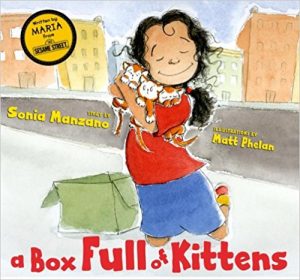 Ruthie loves Superman. Ruthie wants to be Superman. And when Ruthie is asked to go spend the afternoon with her aunt, who is about to have a baby any day day now and may need some help., Ruthie seizes the opportunity. It could be her chance to be a hero, should the baby come while she’s visiting! But when Ruthie is out fetching a snack for her aunt, she gets so distracted by a box full of kittens in the bodega that she doesn’t hear her aunt calling for her, nor does she notice the policemen running to the apartment or the ambulance pulling to the curb. When she realizes what’s happened, she’s devastated — she’s missed her one chance to be a hero! Or has she? Sonia Manzano, best known as “Maria” on Sesame Street, once again captures the warmth, love, and adventures of her childhood Bronx neighborhood.
Ruthie loves Superman. Ruthie wants to be Superman. And when Ruthie is asked to go spend the afternoon with her aunt, who is about to have a baby any day day now and may need some help., Ruthie seizes the opportunity. It could be her chance to be a hero, should the baby come while she’s visiting! But when Ruthie is out fetching a snack for her aunt, she gets so distracted by a box full of kittens in the bodega that she doesn’t hear her aunt calling for her, nor does she notice the policemen running to the apartment or the ambulance pulling to the curb. When she realizes what’s happened, she’s devastated — she’s missed her one chance to be a hero! Or has she? Sonia Manzano, best known as “Maria” on Sesame Street, once again captures the warmth, love, and adventures of her childhood Bronx neighborhood.
A five-year-old describes the way her mother is working and coping with problems while her father is in prison.
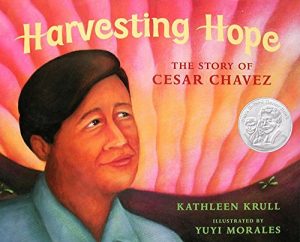 Cesar Chavez is known as one of America’s greatest civil rights leaders. When he led a 340-mile peaceful protest march through California, he ignited a cause and improved the lives of thousands of migrant farmworkers. But Cesar wasn’t always a leader. As a boy, he was shy and teased at school. His family slaved in the fields for barely enough money to survive.
Cesar Chavez is known as one of America’s greatest civil rights leaders. When he led a 340-mile peaceful protest march through California, he ignited a cause and improved the lives of thousands of migrant farmworkers. But Cesar wasn’t always a leader. As a boy, he was shy and teased at school. His family slaved in the fields for barely enough money to survive.
Cesar knew things had to change, and he thought that–maybe–he could help change them. So he took charge. He spoke up. And an entire country listened.
An author’s note provides historical context for the story of Cesar Chavez’s life.